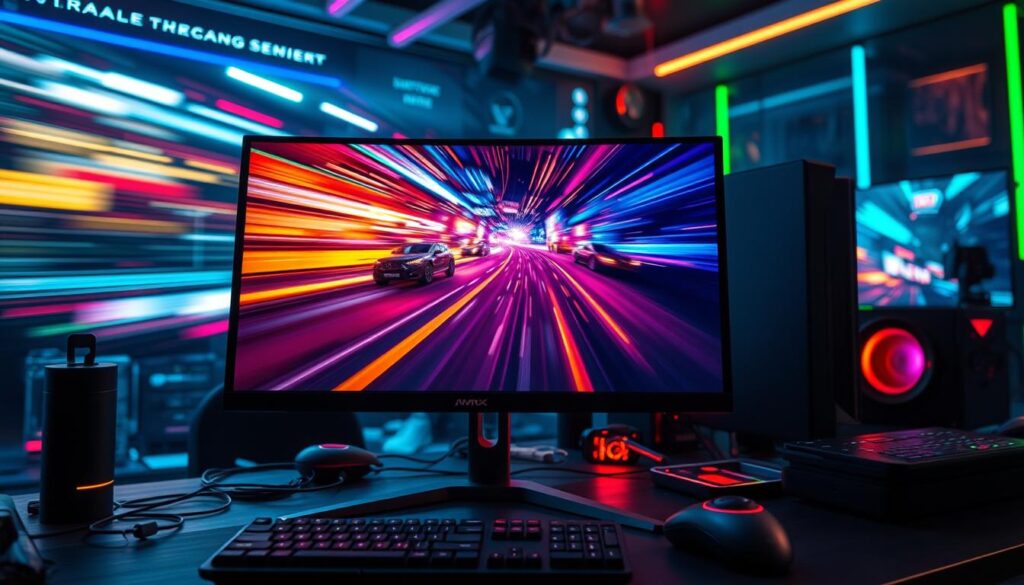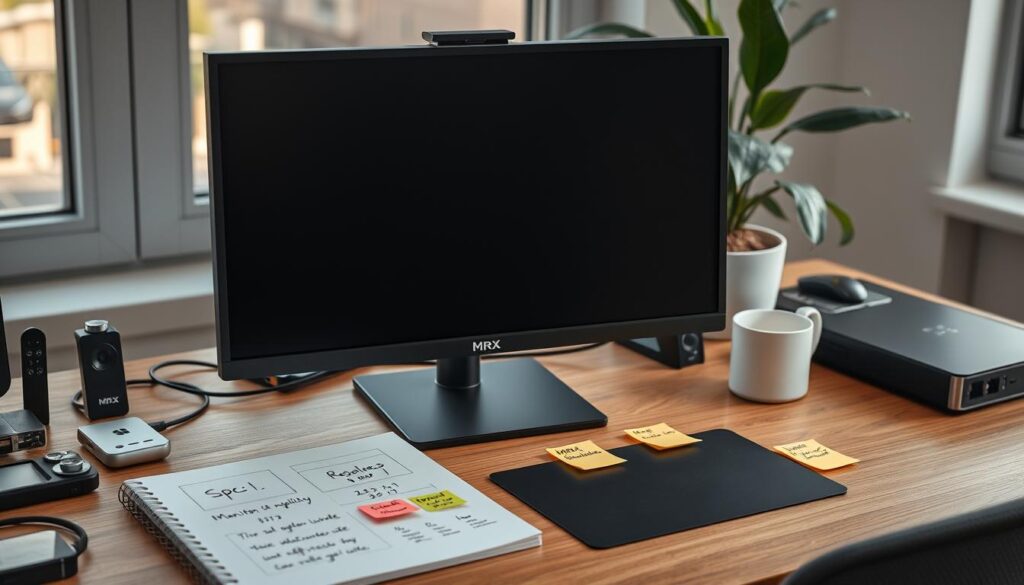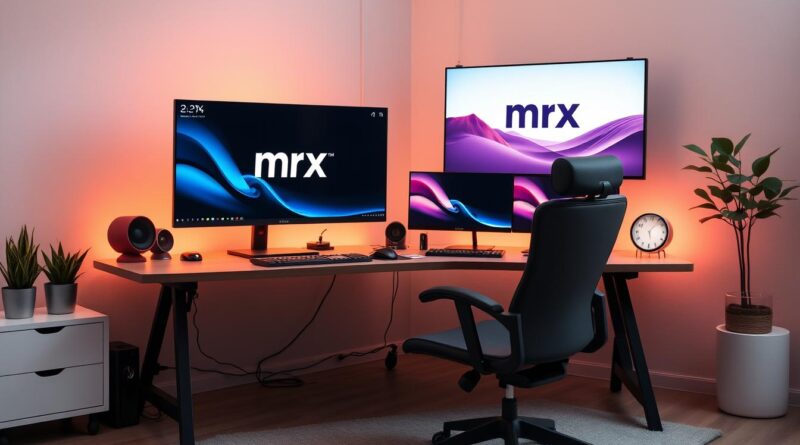How to Guide: Selecting the Right Monitor
Did you know a good monitor can make you 25% more productive? A Harris Poll found that the right display boosts workflow and efficiency. With screens being key for work and fun, picking the right monitor is essential. This guide will help you choose the perfect monitor for your needs.
Key Takeaways
- Identifying your specific usage scenarios is vital for selecting the right monitor.
- Different monitor technologies such as LCD, LED, and OLED cater to various needs.
- Screen size influences viewing comfort and user experience.
- Resolution plays a key role in image clarity and overall satisfaction.
- Understanding refresh rates and response times is essential for gamers and multimedia users.
- Compatible connectivity options can affect your overall setup and usability.
- Brand reputation and warranty terms matter for long-term investment.
Understand Your Needs and Usage
Choosing the right monitor starts with knowing what you need. Different activities require different monitors. Whether you’re into gaming, graphic design, or just general use, figuring out your needs is key. This helps pick the right monitor for now and the future.
Determine Primary Use Cases
How you plan to use your monitor is crucial. Here are a few common scenarios:
- Gaming: Look for high refresh rates and quick response times.
- Creative Work: Choose monitors with excellent color accuracy for design or photo editing.
- Office Work: Focus on screen size and resolution for better productivity.
Identify Essential Features
After deciding how you’ll use your monitor, find the key features you need:
| Feature | Gaming | Creative Work | Office Use |
|---|---|---|---|
| Refresh Rate | High (144Hz or more) | Moderate (60-100Hz) | Moderate (60Hz) |
| Response Time | Low (1ms – 3ms) | Moderate (5ms) | Moderate (5ms) |
| Color Accuracy | Moderate | High (100% sRGB or more) | Moderate |
Consider Future Needs
Think about what you might need in the future. A monitor that can grow with you is a smart choice. Look for features that meet your current needs and can handle new tasks in gaming or work.
Monitor Types Explained
Knowing the different monitor types can help you choose the right one. Each type has its own benefits and drawbacks. It’s important to think about what you need and like. This section talks about LCD, LED, and OLED monitors, and also compares curved and flat screens. We’ll also look at the differences between gaming and professional monitors.
LCD vs. LED vs. OLED
Choosing between LCD, LED, and OLED monitors is a big decision. LCD monitors are affordable and reliable. LED monitors are brighter and use less energy because of their LED backlight. OLED monitors have deeper blacks and colors because their pixels light up themselves.
This makes OLED great for tasks that need lots of color and detail.
Curved vs. Flat Screens
Curved screens are popular among gamers. They make games feel more real by showing more of the screen. Flat screens are still good for most things but don’t offer the same immersive feel as curved screens.
If you want a better gaming or movie experience, curved screens might be the way to go.
Gaming Monitors vs. Professional Monitors
Gaming monitors have fast refresh rates and quick response times. This means smoother games and less blur. They also have special features like adaptive sync and color profiles you can change.
Professional monitors, on the other hand, focus on color accuracy and wide color gamuts. They’re perfect for graphic design, video editing, and other creative work.
| Monitor Type | Key Features | Best For |
|---|---|---|
| LCD Monitors | Affordable, reliable, decent brightness | General use, office work |
| LED Monitors | Brighter images, energy-efficient | Everyday use, casual gaming |
| OLED Monitors | Vibrant colors, deep blacks | Graphic design, high-end gaming |
| Curved Screens | Immersive experience, wider field of view | Gaming, movies |
| Flat Screens | Standard viewing, traditional design | General use, professional settings |
Screen Size Considerations
Choosing the right monitor size is key for a great experience. Whether for gaming, work, or everyday use, it’s important to pick a size that fits your space. This guide will help you measure your area, find the best size for your needs, and understand the importance of viewing distance and size ratios.
Measuring Your Space
Before buying a monitor, it’s crucial to measure your space accurately. This ensures the monitor fits perfectly. Measure the width, height, and depth of the area for your monitor. Also, think about where your keyboard and mouse will go to make sure everything fits well.
Ideal Sizes for Different Use Cases
The right monitor size depends on how you plan to use it:
- General Use: A size between 24 and 27 inches is usually a good choice for everyday use.
- Professional Work: For tasks like design, coding, or data analysis, 27 to 32 inches is best. It allows for multiple windows open at once.
- Gaming: Gamers often prefer monitors between 27 and 34 inches for a more immersive experience.
Viewing Distance and Size Ratios
Knowing how viewing distance relates to monitor size is important. Larger monitors are best seen from farther away. Here’s a simple rule:
| Monitor Size (inches) | Recommended Viewing Distance (feet) |
|---|---|
| 24 | 2 – 3 |
| 27 | 2.5 – 4 |
| 32 | 3 – 5 |
| 34+ | 4 – 6 |
Resolution and Image Quality
Understanding monitor resolution is key when buying a new display. It affects how clear and detailed images look. Different resolutions meet different needs, like full HD and 4K monitors.
What is Resolution?
The term monitor resolution means the number of pixels in an image. More pixels mean sharper images, making things look better. This is important for tasks that need a lot of detail.
Common Resolutions: Full HD to 4K
| Resolution | Pixel Dimensions | Common Use Cases |
|---|---|---|
| Full HD | 1920 x 1080 | General use, gaming, movies |
| Quad HD | 2560 x 1440 | Professional work, gaming |
| 4K | 3840 x 2160 | Video editing, graphic design, gaming |
Full HD is great for everyday tasks, offering good image quality. On the other hand, 4K monitors have amazing detail. They’re perfect for creatives and professionals who need top-notch displays.
Importance of Color Accuracy
Color accuracy is also crucial in monitor performance. Monitors that accurately show colors make images look better. This is very important for graphic designers, photographers, and videographers who need exact color representation.
Refresh Rate and Response Time
When picking gaming monitors, knowing about refresh rate and response time is key. These specs are crucial for smooth game and media playback. They affect how well games and videos look on your screen.
Understanding Refresh Rate
The refresh rate shows how often a screen updates its image, in Hertz (Hz). A higher rate means smoother visuals and less motion blur in fast games. Most gaming monitors have rates from 60Hz to 240Hz. It’s important to choose one that fits your gaming needs and hardware.
What is Response Time?
Response time shows how fast a pixel changes color, affecting fast image clarity. A quicker response time means less ghosting and better visuals. Monitors often boast response times as low as 1ms, perfect for sharp, smooth gameplay.
How They Affect Gaming and Media
Refresh rate and response time greatly impact gaming. A high refresh rate with a quick response time means better gameplay. It helps players react faster to game actions. Whether playing competitive games or single-player adventures, these specs are crucial for the best gaming experience.

Panel Types: IPS, TN, VA
Knowing about monitor panel types is key to picking the right display. Each type—IPS, TN, and VA panels—has its own strengths and weaknesses. They meet different needs, from performance to budget.
Pros and Cons of Each Panel Type
Each panel has its own set of benefits and drawbacks:
- IPS Panel: It has great color accuracy and wide viewing angles. It’s perfect for graphic design and content creation. But, it’s more expensive than others.
- TN Panel: It’s fast, making it great for gamers. But, it doesn’t do well with color or viewing angles.
- VA Panel: It has the best contrast ratios, ideal for movies or gaming in the dark. But, it’s slower than others.
Best Uses for Each Panel Type
Each panel is best for different activities:
| Panel Type | Best Use Case |
|---|---|
| IPS Panel | Professional graphics work, photo editing |
| TN Panel | Fast-paced gaming, competitive esports |
| VA Panel | Home theater, gaming in dark settings |
Viewing Angles and Color Reproduction
Viewing angles and color are crucial when talking about monitor panels. IPS panels have the best viewing angles and color accuracy. They show colors as they really are.
TN panels struggle with color consistency at different angles. VA panels do better with contrast but not as well with color when viewed from the side.
Connectivity Options
Knowing about different monitor connections is key to getting the most out of your display. Each standard has its own benefits, depending on your needs. Whether you’re into gaming, editing, or just general use, HDMI, DisplayPort, and USB-C are important to consider.
HDMI vs. DisplayPort vs. VGA
HDMI is great for both video and audio, making it a top pick for laptops and home setups. DisplayPort is best for gamers, offering high resolutions and smooth play. VGA is older and limits what you can do today.
| Connection Type | Resolution Support | Audio Support | Best Use Case |
|---|---|---|---|
| HDMI | Up to 4K@60Hz | Yes | Home Entertainment, General Use |
| DisplayPort | Up to 8K@60Hz | Yes | Gaming, Professional Workstations |
| VGA | Up to 1080p | No | Legacy Systems |
USB-C and Thunderbolt Compatibility
USB-C is becoming more popular, offering flexibility for video, data, and charging. It’s a must-have for modern laptops and devices. Thunderbolt takes USB-C to the next level, allowing for fast data transfer and connecting multiple monitors.
Important Ports to Look For
When choosing a monitor, look for these essential ports:
- HDMI – Essential for everyday usage.
- DisplayPort – Ideal for high-performance requirements.
- USB-C – Versatile for newer devices.
- 3.5mm audio jack – Useful for connecting speakers or headphones.
Ergonomics and Adjustability
Creating a comfortable workspace starts with monitor ergonomics. Features like height, tilt, and swivel make a big difference. They let users adjust their screen to fit their needs, improving posture and reducing eye strain.
Importance of Height, Tilt, and Swivel
Being able to change the monitor’s height, tilt, and swivel is key. It helps users keep their screen at eye level, easing neck and eye pain. This setup supports a healthy posture, vital for staying well over time.
Benefits of Adjustable Stands
Adjustable stands boost both comfort and productivity. They let users find the perfect viewing height, cutting down on discomfort. These stands often have gas springs or manual controls, making it simple to change positions all day.
Wall Mounting Options
Wall mounting monitors saves desk space and makes the area look cleaner. It allows for better screen positioning and customizable heights. This adds to the ergonomic benefits, making the workspace even more comfortable.
Budgeting for Your Monitor
Setting a budget is key when picking a monitor. Knowing monitor prices helps match what you want with what you can afford. Prices change based on things like resolution, refresh rates, and panel types. This way, you can choose wisely, balancing quality and cost.
Setting a Realistic Budget
First, think about how you’ll use your monitor. Is it for everyday tasks, gaming, or work? Knowing this helps set a budget that feels right. Looking at different price levels can show you what fits your budget.
Impact of Features on Pricing
Monitor prices change with the features they have. Higher resolution and faster refresh rates cost more. Knowing what you need helps you spend wisely. For example, if you game a lot, a high refresh rate might be more important than 4K resolution.
Best Monitors for Every Budget
It’s possible to find good monitors without spending a lot. Here are some options for different budgets:
| Budget Range | Monitor Example | Key Features |
|---|---|---|
| Under $200 | Acer R240HY | Full HD, IPS Panel |
| $200 – $400 | LG 27UL500-W | 4K UHD, HDR Support |
| Above $400 | ASUS ROG Swift PG259QN | 360Hz Refresh Rate, G-Sync |
By carefully planning your budget, you can find monitors that fit your needs and budget. Understanding how features affect prices helps you make the best choice. This way, you’ll be happy with your monitor purchase.
Brand Reputation and Warranty
When you buy a monitor, the brand’s reputation matters a lot. Brands known for quality and good customer support stand out. Choosing a brand that’s known for durability and service can make you happy for a long time.
Trusted Monitor Brands
Some monitor brands are known for being reliable and performing well. Here are some top picks:
- Dell
- ASUS
- LG
- Samsung
- BenQ
Understanding Warranty Policies
Warranty policies differ among brands. Knowing what’s covered helps protect you from defects and unexpected problems. Important things to look at include:
- How long the warranty lasts
- What the warranty covers
- When the warranty might not apply anymore
Importance of Customer Support
Good customer support makes buying a monitor better. A brand with strong support makes fixing issues and keeping things running smooth easier. Look for:
- How you can get help (phone, chat, email)
- How fast they respond to questions
- What others say about their support
| Brand | Warranty Period | Customer Support Rating |
|---|---|---|
| Dell | 3 Years | 4.5/5 |
| ASUS | 3 Years | 4/5 |
| LG | 1 Year | 4/5 |
| Samsung | 1 Year | 3.5/5 |
| BenQ | 3 Years | 4/5 |
Energy Efficiency and Sustainability
More people want to help the planet, so they look for energy-saving monitors. It’s key to pick monitors with good Energy Star ratings. This means they use less energy and are better for the environment.
Buying eco-friendly tech is good for both you and the planet. It cuts down on harm to the environment and offers big benefits to users.
Energy Star Ratings Explained
Energy Star ratings show how efficient a monitor is. They mean the monitor meets strict energy standards set by the U.S. Environmental Protection Agency. Monitors with this label use less electricity than others, which is great for those who care about energy use.
Benefits of Eco-Friendly Monitors
Eco-friendly monitors are good for the planet and still look great. Brands that care about the environment use materials that are kinder to the earth. They also use less power and can be recycled, making them even more appealing.
Choosing these monitors helps both you and the planet. It’s a win-win for everyone.
Long-Term Savings on Energy Bills
Monitors with Energy Star ratings can save you money over time. They use less power, which means lower energy bills every month. By choosing these monitors, you help save energy and cut down on costs.
This is a smart choice for saving money and helping the planet. It’s a win-win for everyone.
Reviews and Recommendations
Choosing a monitor requires reliable information. User feedback is key, showing real experiences with different models. It highlights performance, quality, and satisfaction, helping buyers make informed choices.
Importance of User Feedback
User feedback is a crucial guide when buying a monitor. Customers share their experiences, offering insights into different monitors. Reviews cover important details like color accuracy and build quality, giving a full picture.
Where to Find Reliable Reviews
Finding trustworthy monitor reviews is essential. Websites like CNET, TechRadar, and Consumer Reports offer in-depth reviews. They provide expert opinions and the latest trends, helping users make informed decisions.
Considering Expert Opinions
Expert recommendations are vital in the monitor market. Professionals test products, examining their performance. Their reviews offer valuable context, helping find the best monitors for specific needs.
Comparison Tools and Resources
Finding the right monitor is easier with today’s tools and resources. You can use online platforms and in-store testing to help you decide. Here are some effective strategies to consider.
Online Comparison Websites
Many online resources help compare monitors. Sites like PCPartPicker track prices across retailers, helping you find deals. DisplaySpecifications offers detailed info on monitor models, including resolutions and panel types. These platforms make comparing products easy.
Using Manufacturer Specs Effectively
Manufacturer specs are key when choosing a monitor. Brands list features, dimensions, and connectivity on their websites. Look for specs like refresh rates and response times to meet your needs. Using these specs with comparison tools helps make better choices.
Benefits of In-Store Testing
In-store testing is a great way to get hands-on experience. Visiting stores lets you see display quality, viewing angles, and comfort. Talking to staff can also give insights not found online. This practical knowledge can make you happier with your monitor.
Maintenance and Care Tips
Keeping your monitor in good shape is key to its long life and performance. Proper care helps avoid problems like screen burn-in and damage. Here are some essential tips to keep your monitor in top condition.
Cleaning Your Monitor Safely
Cleaning your monitor needs careful methods to avoid harm. Use microfiber cloths to gently clean, as they prevent scratches. Choose cleaning solutions that are ammonia-free to ensure they’re safe for your screen. Here are some important do’s and don’ts:
- Do turn off your monitor before cleaning.
- Do apply the cleaning solution to the cloth, not directly onto the screen.
- Don’t use paper towels, as they can cause scratches.
- Don’t use harsh chemicals or solvents on the screen.
Preventing Screen Burn-In
Screen burn-in is a big worry, mainly for OLED displays. To avoid it, follow these steps:
- Use screen savers or set automatic sleep modes when not in use.
- Reduce brightness settings to lessen the potential for burn-in.
- Avoid displaying static images for prolonged periods.
General Maintenance Guidelines
Effective monitor care tips can make your device last longer. Regularly dust around the monitor and check for any cable damage. Keeping your workspace tidy not only boosts efficiency but also ensures good airflow around your monitor. Here are some general maintenance tips:
| Maintenance Task | Frequency | Notes |
|---|---|---|
| Wipe screen with microfiber cloth | Weekly | Avoid using abrasive materials |
| Check cables for wear and tear | Monthly | Replace damaged cables promptly |
| Reorganize workspace for ventilation | As needed | Ensure no objects block airflow |
Final Considerations Before Purchase
Before you buy, think about a few key things to make sure you’re happy with your choice. Knowing when to buy, understanding return policies, and making a smart decision are all important. These steps can make your shopping experience better.
When to Buy: Seasonal Discounts
Buying at the right time can save you a lot of money. Look for sales during holidays, Black Friday, Cyber Monday, or back-to-school. These times offer big discounts. Keep an eye out for these events to save even more.
Importance of Return Policies
Return policies are crucial when buying monitors. Knowing what the store’s policy is can give you peace of mind. A good return policy lets you exchange or return items if they’re not right for you. This makes choosing a monitor easier.
Making Your Final Decision
After thinking about everything, it’s time to decide. Compare what you need with what you’ve learned. Think about the features, price, and warranty. Making a careful choice will ensure you’re happy with your monitor.

Conclusion: Making an Informed Choice
As you finish this guide on picking the right monitor, think about the key points covered. You learned about your needs and the types of monitors out there. You also discovered how resolution, refresh rates, and ergonomics matter.
Recap of Key Points
When choosing a monitor, start by knowing what you need and want. Learn about different technologies, connections, and prices. This helps you pick the best monitor for your use, whether it’s gaming, work, or watching videos.
Encourage Active Decision-Making
Being active in your buying process is important. Use reviews, comparison tools, and try out monitors if you can. This will help you feel sure about your choice. Making good choices will make you happy with your monitor in the long run.
Next Steps for Purchase
Now you have all the info you need. Look for sales, check return policies, and stick to your budget. Stay informed and careful, and you’ll find a monitor that fits your needs perfectly.
FAQ
What should I consider when selecting the right monitor?
When picking a monitor, think about resolution, size, and panel type. Also, consider refresh rate, response time, and color accuracy. Choose based on your needs, like gaming or work.
How does monitor resolution affect image quality?
Resolution affects how clear and detailed images are. Higher resolutions, like 4K, make images sharper. They also give more space for multitasking compared to lower resolutions like Full HD.
What is the difference between refresh rate and response time?
Refresh rate shows how often the monitor updates the image, in Hertz (Hz). A higher rate means smoother visuals, great for gaming. Response time is how fast pixels change color, affecting motion blur and clarity.
Are all panel types the same when it comes to color accuracy and viewing angles?
No, different panels have different strengths. IPS panels are best for color and wide viewing angles. TN panels are faster but less accurate. VA panels have better contrast but slower performance.
What screen size is ideal for my workspace?
The best screen size depends on your space and viewing distance. Sizes between 24-32 inches work for most. Measure your space and think about what you prefer for the best experience.
How important are connectivity options when choosing a monitor?
Connectivity options are key for device compatibility. Look for monitors with HDMI, DisplayPort, and USB-C. These offer flexibility and easy connections.
Can ergonomics affect my comfort during prolonged monitor use?
Yes, ergonomics are crucial for comfort over time. Features like height adjustment and tilt reduce neck and eye strain. Wall mounting can also improve ergonomics by freeing up desk space.
How can I find reliable monitor reviews before making a purchase?
Check out reviews on tech sites like CNET, TechRadar, or Consumer Reports. User feedback also gives insights into a monitor’s performance and reliability.
What should I be aware of regarding warranties when purchasing a monitor?
Warranty policies are important for protection. Good brands offer warranties for defects. Always read the warranty details, including duration and support options.
Are energy-efficient monitors worth considering?
Yes! Energy-efficient monitors save energy and money over time. They often have Energy Star ratings, making them better for the environment.
When is the best time to buy a monitor?
Look for discounts during seasonal sales, like Black Friday or back-to-school. Buying during these times can save you money.



